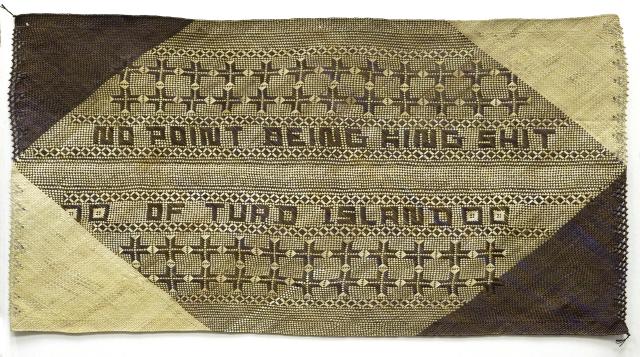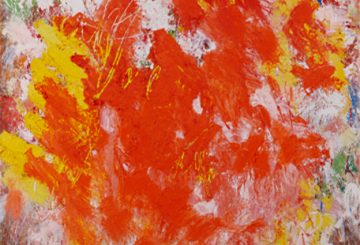As Newell Harry might ask, what’s the point of being king sh_t of turd island? Heaps, says Carrie Miller…
Newell Harry, (Untitled) No point being king shit of turd island, 2007.
Hand-woven pandanus and dye, 122 x 227 cm (irregular)
Collection Queensland Art Gallery. Image courtesy the artist and Roslyn Oxley9 Gallery, Sydney
Copyright © the artist
I turned up to the Biennale with a dumb prejudice about what I thought its premise was: the celebration of difference. I was determined to resist that kind of party. Even with this surly attitude, the first works I encountered – Newell Harry‘s deceptively modest works – managed to hold my attention, hanging with a quiet strength at the entrance to the cavernous Pier 2.
The artist’s series of text-based pieces consist of sardonic messages and word plays on woven mats – traditionally made by Vanuatu women for the purposes of trade or as ceremonial gifts. They sit against the first wall like welcome mats – to the Bienniale and its themes certainly – but also to a part of the art world I like to inhabit, a personal space where I can engage with work that evoke sense memories and spark ideas and associations that hold meaning for me.
What elevates Harry’s work is that it manages to do this through an unfamiliar materiality and taxonomy. What do I know of the cultural practices of the Vanuatu people? What does it mean to inscribe a mat with the phrases F_CK KNUCKLE and UNCLE PAT? But there is a sense of familiarity to these works that I think stems precisely from their cultural specificity – the particularity of vernacular experience that we can all understand. Perhaps this exemplifies what seems to be embedded in the overarching theme of the Biennale itself: the Beauty of Distance. Cultural difference can only be understood if there is some shared horizon point around which we can gather ourselves to appreciate, if not each other, then at least interesting bits of culture like Newell Harry’s.



I loved this work despite it being in the WORST place in the Biennial.